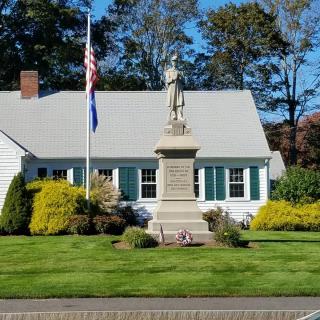A Brief History of Raynham, Massachusetts

The area that is now known as the city of Taunton was first settled in 1639. Iron ore was discovered in Taunton on the banks of the Two Mile (Forge) River in 1652. After the discovery of the iron ore, a group of 23 people formed a partnership to start up the iron works. The iron works began somewhere between 1652 and 1656. This section of Taunton, the east end, where the iron works were located, became the Town of Raynham.
Raynham was incorporated as a town on April 2, 1731. The Leonard, Jones, Washburn, King, Shaw, Dean, Hall, Gushee, Williams, Gilmore, Andrews, Hathaway, White, Tracy and Knapp are cited as the founding families of Raynham, and their descendants held prominent positions in the town until well into the 20th century.
Town leaders, from the first families, partitioned the Massachusetts General Court three times before they were allowed to become independent from Taunton. The Court set the following requirements for Raynham's succession from Taunton: "That the inhabitants of said town do, within the space of three years from the publication of this act, procure and settle a learned and orthodox minister of good conversation, and make provisions for his comfortable and honorable support and likewise provide a schoolmaster to instruct their children to read and write."
The iron works were the dominant industry in the town for more than two centuries. The importance that was attached to iron works is apparent from the town seal which depicts the iron works along with the date 1652. The Raynham iron works were not the oldest in the state. Iron works in Lynn, Saugus and Braintree were started prior to those in Raynham. However, the iron works in Raynham have the distinction of being the iron "manufactory"
that was in continuous operation for the longest period of time. The iron works continued to operated in Raynham until 1873.
Ship building was also part of Raynham's early economy. Ridges were cut into the banks of the Taunton River to form cradles for the boats. The ridges of the banks were used as staging and as a means to shore up or brace the ships. The timbers were floated across the Taunton River to the approximate site of the staging areas and then dragged up the banks to the ships by the oxen. The small schooners that were built this way weren't completely finished in Raynham. In the spring, when the water is usually the highest, they were sailed down river to Berkley or Fall River for the final fittings.
The property where the shipbuilding took place was owned by the Reverend Silas Hall and other members of the Hall family.
In the 1840s, the railroad ran through Raynham for the first time. The railroad tracks were located in North Raynham and the lines ran from Boston to New Bedford. The advent of the railroad helped the growth of the town.
During the 1800s and well into the 1900s, Raynham had several small cottage industries that included: a tack factory, a grist mill powered by a dam on Johnson's pond, sawmills, a bleachery, a straw hat factory, and several shoe "manufactories". Prior to the advent of the mechanization of the shoe industry, shoes were frequently made in small shops that were sometimes located adjacent to the owners' homes. Raynham had several of these small shoe shops.
A box factory, owned by George Williams, was located very close to the saw mill on Richmond Street. That site is now occupied by industrial property.
The boxes that were manufactured there were used to store fish. Each day, trucks delivered the boxes to fishing ports such as New Bedford, Provincetown, Plymouth, Boston and Sakonnet and Newport, RI. At some point in the mid 1900s, fish was no longer packaged in wooden boxes. Around this time the factory lost its profitability.
Although, Raynham did have these small industries, it was still very much a rural town with an agrarian base. Farming was important in Raynham, and at one point a census listed more animals than people. Several small farms in Raynham specialized in growing a variety of fruit: strawberries, peaches and apples. One farm in Raynham raised over 39 varieties of apples.
Today, almost all of the farm land has been developed for housing and business use. Raynham has grown from a town with no street signs and a trolley running through that connected it to the surrounding towns, to a community with a population of over 11,000. Raynham does retain some characteristics of its rural beginnings. It is one of the few towns left in Massachusetts with a private library.

